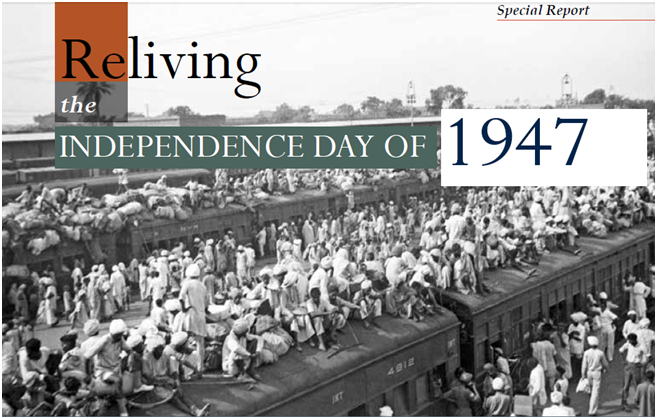
India attained freedom from the British Raj on August 15, 1947 after being ruled by them for over two centuries. On 15 August 1947, the first Prime Minister of India, Jawaharlal Nehru raised the Indian national flag above the Lahori Gate of the Red Fort in Delhi.
But the independence of our country coincided with the partition of India, in which the British India was divided along religious lines into the Dominions of India and Pakistan.
In the year 1947, Lord Mountbatten released the 3 June Plan on partition of India as legislature representatives of the Indian National Congress, the Muslim League, and the Sikh community came to an agreement with Lord Mountbatten. Nobody who agreed to the plan realised that partition was unleashing one of the worst calamities of the 20th century. As per this plan, 'The Independence Act' of 1947 was implemented. This was the last plan for independence.
To decide the fate of 400 million Indians and draw lines of division on poorly made maps, Mountbatten brought in Cyril Radcliffe, a barrister who had never set foot in India before then, and would never return afterwards. Mountbatten gave him just five weeks to complete the job. All of India, and particularly those in Bengal and Punjab, waited with bated breath to find out how they would be divided.
Working feverishly, Radcliffe completed the partition maps days before the actual partition. Mountbatten, however, decided to keep them secret. On Mountbatten’s orders, the partition maps were kept under lock and key in the viceregal palace in Delhi. They were not to be shared with Indian leaders and administrators until two days after partition.
It was not just rivers and gold and silver that needed to be divided between the two dominions; it was books in libraries, and even paper pins in offices.
What followed was a period of absolute terror, which, by some estimates, saw more than a million killed. There was nothing that could have prepared the approximately fifteen million refugees for this nightmare. Leaving behind land and properties, people began to migrate to India or Pakistan, forced to relocate. Many never made it. Millions of refugees poured across the borders to regions completely foreign to them, causing catastrophic riots. Most people did not participate in the violence and were largely innocent victims.
As the clock struck midnight on August 15, 1947, celebratory shouts of freedom from colonial rule were drowned out by the cries of millions frantically making their way through the corpse-littered landscape of India and Pakistan.
Lord Mountbatten, the last Viceroy, was asked by the Indian leaders to continue as the Governor-General of India. Jawaharlal Nehru became the Prime Minister of India and Sardar Vallabhbhai Patel became the Home Minister. Muhammad Ali Jinnah became the Governor-General of Pakistan, and Liaquat Ali Khan became the Prime Minister of Pakistan.
The state of Jammu and Kashmir was contiguous to both India and Pakistan, but its Hindu ruler chose to remain initially independent. Following a Pakistani tribal invasion, he acceded to India on 26 October 1947, and the state was disputed between India and Pakistan. Boundary issues, left unresolved by the British, have caused two wars and continuing strife between India and Pakistan.
The Constituent Assembly completed the work of drafting the constitution on 26 November 1949; on 26 January 1950 the Republic of India was officially proclaimed.
Independence Day is marked throughout India with flag-raising ceremonies, drills, and the singing of the Indian national anthem. But what remains incomprehensible is the silence that was allowed to shroud the Partition violence.
Up to two million people lost their lives in the most horrific of manners. The darkened landscape bore silent witness to trains laden with the dead, decapitated bodies, limbs strewn along the sides of roads, and wanton rape and pillaging. There was nothing that could have prepared the approximately 14 million refugees for this nightmare. The 1947 Partition of the Indian subcontinent into the independent nations of Hindu-majority India and Muslim-majority Pakistan was accompanied by one of the largest mass migrations in human history and violence on a scale that had seldom been seen before. As the provinces of the Punjab and Bengal were effectively split in half approximately seven million Hindus and Sikhs and seven million Muslims found themselves in the wrong country. Believing they would return "home," many families left their valuables behind before they packed up their essential belongings and began the trek to India or West or East Pakistan (now Bangladesh). Many never made it.
It becomes ever harder, today, to imagine the pre-partitioned Indian subcontinent. Partition in 1947 is not just an event in the history; for millions, it is a synonym for horror.
Amrita Bhattacharjee
To read the further articles please get your copy of Eastern Panorama August issue @http://www.magzter.com/IN/Hill-Publications/Eastern-Panorama/News/ or mail to contact @easternpanorama.in


